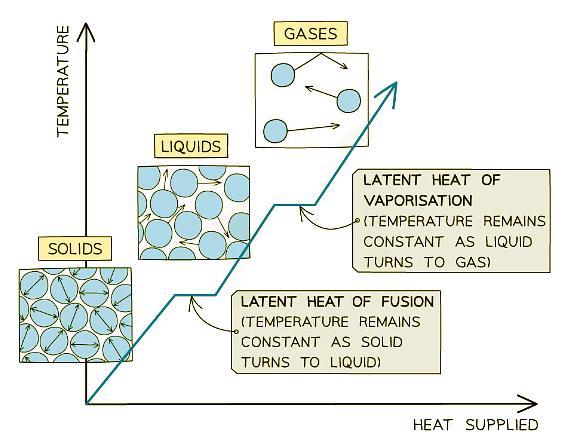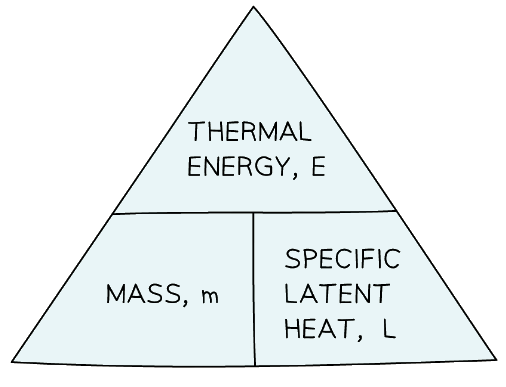Grade 10 Exam > Grade 10 Notes > Physics for Grade 10 > Specific Latent Heat
Specific Latent Heat | Physics for Grade 10 PDF Download
| Table of contents |

|
| Introduction |

|
| Latent Heat of Fusion |

|
| Latent Heat of Vaporisation |

|
| Tips |

|
| Calculating Specific Latent Heat |

|
Introduction
- Energy is required to change the state of a substance
- This energy is known as latent heat
- The specific latent heat is defined as:
- The amount of thermal energy required to change the state of 1 kg of a substance with no change in temperature
- There are two types of specific latent heat:
- Specific latent heat of fusion (solid to liquid and vice versa)
- Specific latent heat of vaporisation (liquid to gas and vice versa)
- Latent heat is represented by the symbol L with units joules per kilogram (J/kg)
 The changes of state with heat supplied against temperature
The changes of state with heat supplied against temperature
Latent Heat of Fusion
- More specifically, the specific latent heat of fusion is defined as:
- The thermal energy required to convert 1 kg of solid to liquid with no change in temperature
- This is used when melting a solid or freezing a liquid
- When a solid substance is melted, its temperature stays constant until all of the substance has melted
- The latent heat of fusion is the energy needed to break the bonds between the molecules
- If the substance in its liquid state is cooled, it will solidify at the same temperature as its melting point
- When this happens, the particles bond together into a rigid structure
- Latent heat is transferred to the surroundings as the substance solidifies and the particles form stronger bonds
Latent Heat of Vaporisation
- The specific latent heat of vaporisation is defined as:
- The thermal energy required to convert 1 kg of liquid to gas with no change in temperature
- This is used when vaporising a liquid or condensing a gas
- When a liquid substance is heated, at its boiling point, the substance boils and turns into vapour
- The latent heat of vaporisation is the energy needed by the particles to break away from their neighbouring particles in the liquid
- If the substance in its gas state is cooled, it will condense at the same temperature as its boiling point
- Therefore, latent heat is transferred to the surroundings as the substance condenses into a liquid and its particles form new molecular bonds
 |
Download the notes
Specific Latent Heat
|
Download as PDF |
Download as PDF
Tips
- The specific latent heat of fusion and vaporisation value of all substances will be provided for you in the exam question, so you do not need to memorise the value of any.
- However, make sure to include 'with no change in temperature' in your definition of specific latent heat to be awarded full marks.
- Use these reminders to help you remember which type of latent heat is being referred to:
- Latent heat of fusion = imagine ‘fusing’ the liquid molecules together to become a solid
- Latent heat of vaporisation = “water vapour” is steam, so imagine vaporising the liquid molecules into a gas
Calculating Specific Latent Heat
- The amount of energy E required to melt or vaporise a mass of m with latent heat L is:
E = mL - Where:
- E = thermal energy required for a change in state, in joules (J)
- m = mass, in kilograms (kg)
- L = specific latent heat, in joules per kilogram (J/kg)
- This equation can be rearranged with the help of a formula triangle:

- For context, the values of latent heat for water are:
- Specific latent heat of fusion = 330 kJ/kg
- Specific latent heat of vaporisation = 2.26 MJ/kg
- Therefore, evaporating 1 kg of water requires roughly seven times more energy than melting the same amount of ice to form water
Solved Example
Example: Calculate the energy transferred to the surroundings as 0.60 kg of stearic acid changed state from liquid to solid.The specific latent heat of fusion of stearic acid is 199 000 J/kg.
Step 1: List the known quantities
- Mass, m = 0.60 kg
- Specific latent heat of fusion, L = 199 000 J/kg
Step 2: Write down the relevant equation
E = mL
Step 3: Substitute in the values
E = 0.60 × 199 000 = 119 400 J
The document Specific Latent Heat | Physics for Grade 10 is a part of the Grade 10 Course Physics for Grade 10.
All you need of Grade 10 at this link: Grade 10
|
124 videos|149 docs|37 tests
|
Related Searches






























